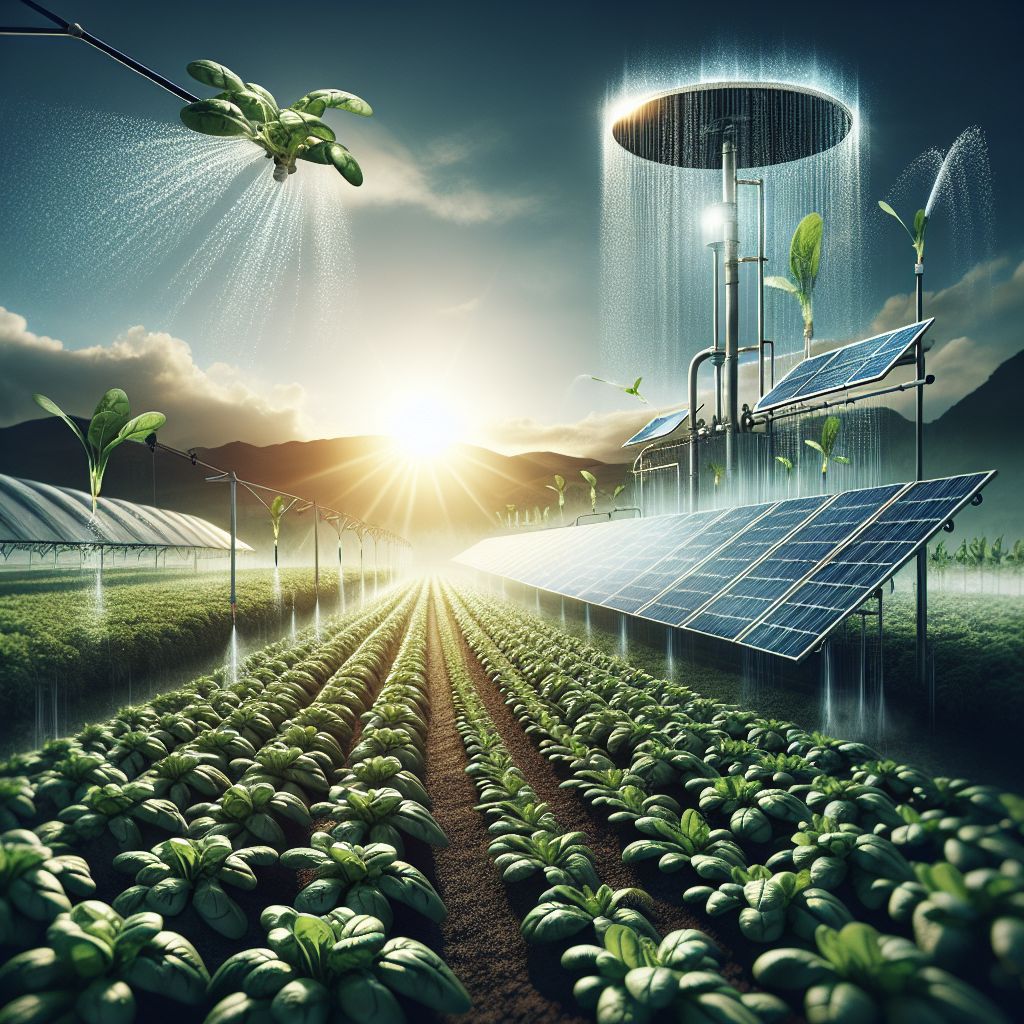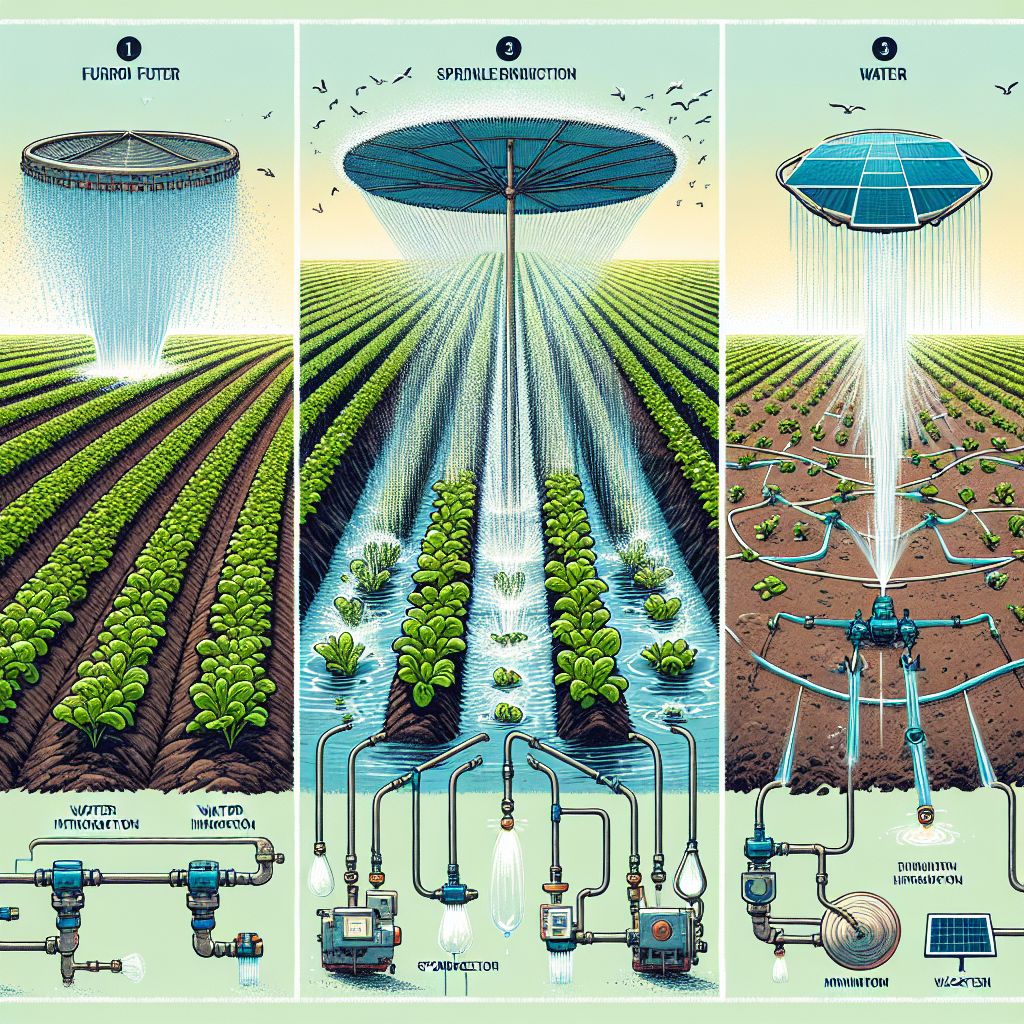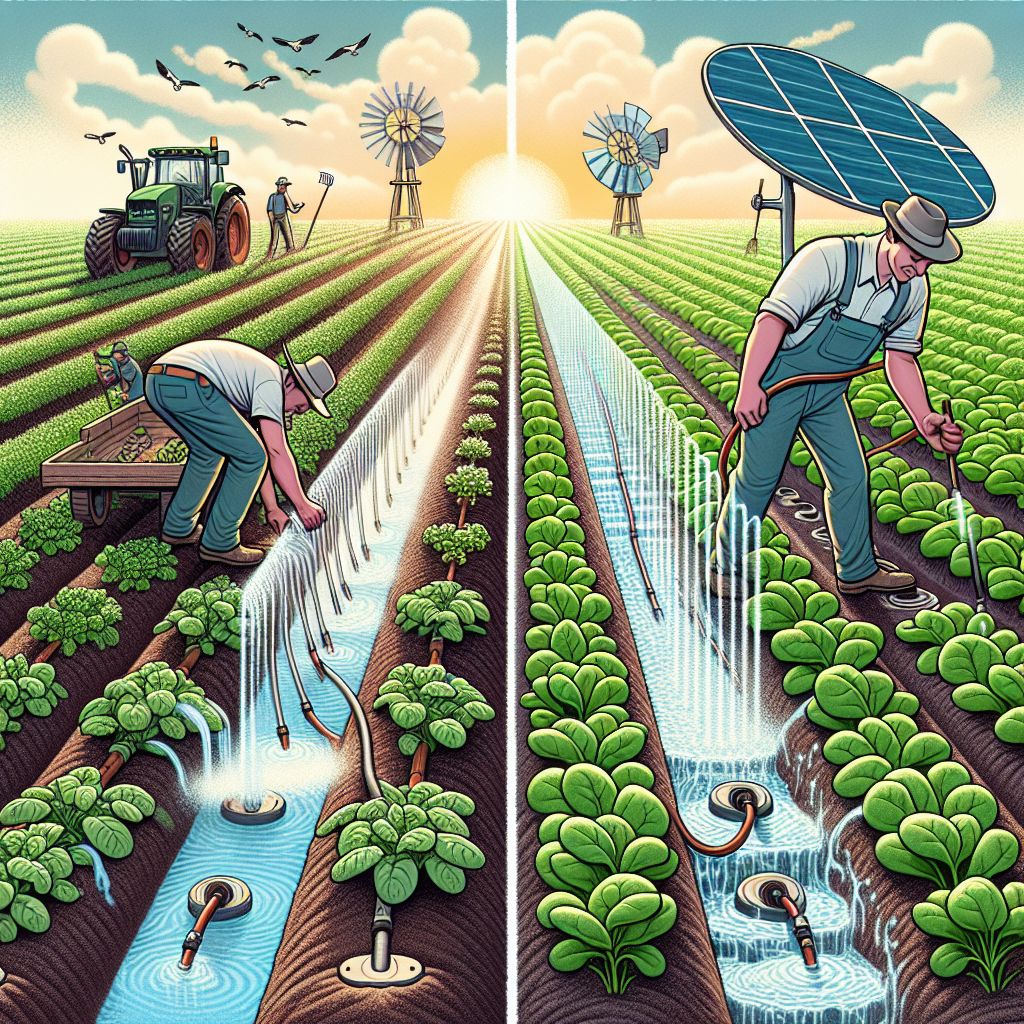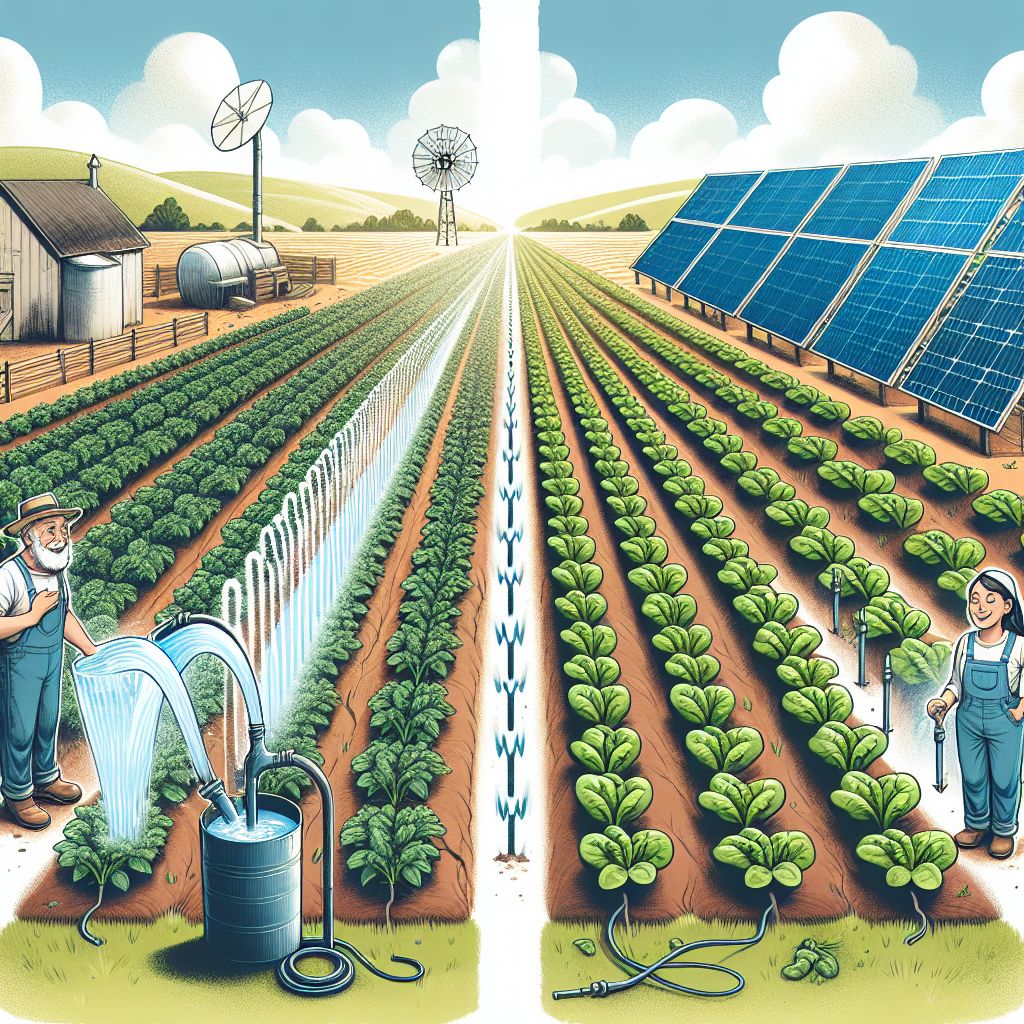
Key Takeaways
By using solar irrigation systems, farming can reduce its carbon footprint and use renewable energy.
These systems can lead to long-term cost savings for farmers and increase their energy independence.
As part of solar irrigation, drip irrigation is very efficient for conserving water and growing spinach.
The efficiency of the irrigation system depends on choosing the right type of solar panels.
Higher spinach yields and better crop quality can be achieved by adopting solar irrigation systems.
As we strive for a greener future, the combination of solar power and irrigation systems is perfect for eco-friendly farming. Let’s look at how solar irrigation systems can change the way we grow spinach, a versatile and nutritious crop.
The Benefits of Merging Solar Panels and Irrigation Systems
Utilizing Renewable Energy for Farming
Picture a farm where the sun not only helps the crops grow, but also fuels their development. Solar irrigation systems take advantage of the sun’s limitless energy, converting it into a dependable power supply for watering crops such as spinach. This isn’t just environmentally friendly; it’s intelligent farming.
Lowering Farming’s Contribution to Climate Change
Old-school farming techniques frequently use fossil fuels, which adds to the production of greenhouse gases. A switch to solar irrigation systems can drastically lower a farmer’s carbon footprint. This is a small shift that can make a big difference.
Long-Term Savings and Energy Autonomy
Despite the initial investment in solar panels, the long-term benefits can’t be denied. After the panels are installed, solar energy is free, which can drastically reduce electricity costs and provide freedom from fluctuating energy prices.
Enhanced Dependability and Functionality
Solar irrigation systems are not just environmentally friendly, but they are also remarkably dependable. They deliver a steady water supply to your spinach crops, making sure they grow robust and vigorous, irrespective of power failures or grid complications.
Progress in Solar-Powered Irrigation
Technology has come a long way, and now we have solar irrigation systems that can be set to water your crops at the best times. This helps to prevent wasting water and makes sure that every drop is used to its fullest.

Different Irrigation Systems for Spinach Farming
Introduction to Furrow, Sprinkler, and Drip Irrigation Techniques
There isn’t a single perfect method for watering spinach. Furrow irrigation drowns the field, which can be wasteful. Sprinkler systems act like rain but can also be wasteful. Drip irrigation, however, delivers water straight to the roots, reducing waste and improving efficiency.
Adjusting Watering Methods for Spinach Growth
Spinach does well with regular moisture but doesn’t like waterlogged roots. Drip irrigation systems are great for keeping this balance. When they’re powered by solar energy, they offer a green solution that’s good for the crops and the planet.
Smart Watering: Keeping Soil Moisture and Plant Needs in Check
By utilizing intelligent sensors and timers, solar-driven drip irrigation systems have the ability to automatically adapt watering schedules in accordance with soil moisture levels. This guarantees that spinach plants receive the appropriate amount of water when they need it, resulting in the best possible growth.
Why Timing Matters When Watering Spinach
Getting the watering schedule right is crucial. Overwatering can lead to disease, while underwatering can kill the spinach. A solar-powered irrigation system can help you get the timing just right for a bountiful harvest.

Cost and Increased Efficiency: Traditional (Furrow, and Sprinkler) Versus Modern (Drip) Irrigation Systems for Growing Spinach on a Farm
First and foremost, we need to look at the practical aspects of water use efficiency. Which system actually saves more water? This is a crucial question, because water isn’t just a valuable resource—it’s the life of your farm.
Comparing Water Use Efficiency: Which System Saves More?
When it comes to conserving water, drip irrigation is the clear winner. This is because it delivers water directly to the root zone, reducing evaporation and runoff. Traditional methods such as furrow and sprinkler systems often result in a lot of water wastage. And when you power your drip system with solar energy, you’re not just saving water, you’re also using a sustainable energy source.
Upkeep and Longevity: What You’ll Spend in the Long Run
Solar irrigation systems are a cinch to maintain. They have fewer moving parts than traditional systems, so there’s less that can break. Plus, solar panels can keep going for decades, so they’re a smart buy for the long term.
How Spinach Yield and Quality are Affected
Furthermore, having the correct irrigation system can greatly impact the yield and quality of your spinach. Regular and accurate watering results in strong growth and nutrient-dense leaves. That’s exactly what solar-powered drip irrigation provides—it’s a revolutionary tool for crop results.

Different Solar Panels You Can Incorporate into the Irrigation System for Spinach Cultivation on a Farm
Let’s discuss the solar panels now. All panels are not made the same, and the selection you make will affect the efficiency of your irrigation system.
Choosing a Solar Panel: Mono-crystalline, Poly-crystalline, or Thin-Film?
When it comes to solar panels, you mainly have three options: mono-crystalline, poly-crystalline, and thin-film. Each one has its own advantages and is better suited to certain needs and budgets.
Why Monocrystalline Panels Are Your Best Bet for Efficiency
If you’re after efficiency, you can’t go wrong with monocrystalline panels. They’re great performers even when the light isn’t optimal and they don’t take up much space, making them perfect for those with limited land.
Polycrystalline Panels: Reliable and Affordable
Polycrystalline panels are slightly less efficient but are more cost-effective. They’re a fantastic choice if you’re aiming to balance performance with cost.
Thin-Film Panels: The Latest, Bendable Choice
Thin-film panels are the most recent addition. They are lightweight, bendable, and function effectively on surfaces that aren’t level. However, they typically need more area and don’t last as long.
Monocrystalline panels: Ideal for efficiency and saving space
Polycrystalline panels: A budget-friendly option for moderate efficiency
Thin-film panels: Flexible and light, suitable for non-traditional surfaces
Right below is a table looking at all the different solar panel options:
|
Solar Panel Type |
Efficiency Range |
Advantages |
Disadvantages |
|---|---|---|---|
|
Monocrystalline |
17-22% |
Highest efficiency, space-saving, long lifespan. 2 | |
|
Polycrystalline |
15-17% |
Lower efficiency, requires more space. 2 | |
|
Thin-Film |
10-13% |
Lightweight, flexible, good temperature coefficient. 2 |
Lowest efficiency, requires large area. 2 |
|
Portable Solar Panel Systems |
Varies based on panel type |
Designed for irrigation needs, easy to move and relocate. 1, 3 | |
|
Hybrid Solar Panels |
Varies based on components |
Can combine solar with other energy sources like wind, increased reliability. 4 |
More complex system, higher cost. 4 |
Monocrystalline panels provide the highest efficiency in a compact area but at a higher upfront cost (2, 3). Polycrystalline panels offer a balance of efficiency and cost (2, 3). Thin-film panels have lower efficiency but perform better in high temperatures (2). Portable solar panel irrigation systems allow flexibility in placement and relocation as needed (1). Hybrid systems increase reliability by combining solar with other renewable sources but add complexity (4). The optimal choice depends on factors like available space, budget, local climate conditions, and specific irrigation requirements for the spinach.
Choosing the Right Solar Panels for Your Farm
Selecting the right solar panels for your farm involves understanding your land, your budget, and your objectives. Think about how much space you have, how much power you need, and how much you’re willing to spend upfront for long-term benefits.
How to Add Solar Panels to Your Current Farm Setup
Adding solar panels to your current farm setup is easier than you might think. Start with an energy audit to determine your needs. Then, work with a professional to design a system that fits your farm’s layout and your crop’s watering needs.

Regular Irrigation Systems Versus Solar Irrigation Systems: A Comparison of Costs and Efficiency in Spinach Cultivation
Let’s take a closer look: how do the costs and efficiency of solar irrigation systems compare to regular irrigation systems? This is an important factor for any farmer considering a change.
Take, for instance, a farmer in California who switched out their old irrigation system for a solar-powered drip system. They found that, even though the initial setup cost was higher, they saved 30% on water bills and reduced their energy costs by 40% within the first year.
Understanding the Economics of Solar Irrigation
The economics of solar irrigation are convincing. The initial investment includes the cost of solar panels, batteries, controllers, and the irrigation system itself. However, once installed, the operational costs drop dramatically, as sunlight is free. Over time, the savings on water and energy can be significant.
Improvements in Solar Irrigation Efficiency Thanks to Technology
Technology is always pushing the boundaries of what’s possible with solar irrigation systems. Modern systems are more efficient and reliable than ever before, thanks to advancements in panel design, battery storage, and water delivery systems.
So, even though a solar irrigation system may be more expensive initially than conventional methods, the long-term advantages—both economic and environmental—are evident. It’s an investment in your farm’s future and the world’s.
Practical examples from around the world are not only inspiring, but also show that solar irrigation systems are not just a futuristic idea, but a practical reality. Farmers around the world are already reaping the benefits of this technology.
Real-World Success Stories and Data
Consider a farmer in Spain who chose to invest in a solar irrigation system. They were able to keep their spinach crops alive during dry spells by using the plentiful sunshine, without depending on the grid. Their water usage went down by 25%, and their energy bills were reduced by 50%. These are the types of stories that demonstrate the real potential of solar irrigation systems in farming.
Government Backing and Encouragement for Eco-Friendly Methods
Across the globe, governments are starting to appreciate the importance of eco-friendly farming methods. In a lot of places, perks like tax reductions, grants, or low-interest loans are on offer to farmers who decide to put in place solar irrigation systems. These perks not only make the change more cost-effective, but also indicate a move towards a more eco-friendly farming sector.
Solar irrigation is more than just a farming tool. It’s a way for farmers to participate in the larger effort to conserve our natural resources and protect the environment by using less water and energy.
This table compare the pros and cons of solar-powered irrigation systems and conventional irrigation systems:
|
Aspect |
Conventional Irrigation System |
Solar-Powered Irrigation System |
|---|---|---|
|
Pros |
No ongoing energy costs, uses free solar power. 5 | |
|
Simple installation and maintenance. 1 |
Environmentally friendly, reduces carbon footprint. 3 | |
|
Reliable water supply even during power outages. 5 | ||
|
Long lifespan of solar panels (25-30 years). 5 | ||
|
Cons | ||
|
Susceptible to power outages. 5 |
Requires some technical knowledge for installation/maintenance. 3, 4 | |
|
Environmental impact from energy use. 3 |
Risk of over-abstraction of groundwater if not managed properly. 3, 4 | |
|
Potential for water waste/inefficiency. 1 |
Wrapping Up:
To wrap up, pairing solar panels with irrigation systems offers a fantastic chance for farmers to make the most of their water, cut costs, and make a significant step toward sustainable farming. The initial investment is balanced out by the long-term savings and the benefits to the environment, making solar irrigation a wise decision for any farmer, particularly those growing crops that require a lot of water, such as spinach.
Adopting Solar Irrigation for a Greener Tomorrow
As cultivators, we owe it to our earth and our neighborhoods to adopt solar irrigation. It’s a potent method to fulfill that obligation. It’s about gazing into the future and acknowledging that sustainable cultivation is not just feasible, but also essential for our ongoing well-being.
Wrapping it Up: Should Spinach Farmers Invest in Solar?
Should spinach farmers invest in solar irrigation? The answer is a resounding yes. The water savings, energy independence, and long-term cost reductions that come with solar irrigation systems make them a smart choice for any farmer who wants to grow spinach in a more sustainable, efficient way.
Common Questions
What benefits do solar panels provide for irrigation?
Using solar panels for irrigation offers several benefits, such as lower energy expenses, decreased dependence on the electrical grid, and utilization of a sustainable energy source. Furthermore, solar panels can provide more uniform irrigation, leading to better crop growth and quality.
What role do solar irrigation systems play in saving water?
When solar irrigation systems are used in conjunction with drip irrigation methods, they help save water by delivering it straight to the roots of the plants, thereby minimizing evaporation and runoff. This focused watering method guarantees that every drop of water is put to good use.
Is it possible to upgrade current irrigation systems to solar?
Indeed, it is often possible to upgrade current irrigation systems to solar. There are numerous solar irrigation kits on the market that are designed to retrofit existing setups, making the transition to solar a viable choice for many farmers.
Can solar irrigation systems work for small farms?
Absolutely. Solar irrigation systems are flexible and can be adjusted to fit any farm size. Small farms can greatly benefit from the lower operating costs and improved sustainability that solar systems offer.







Leave a Reply